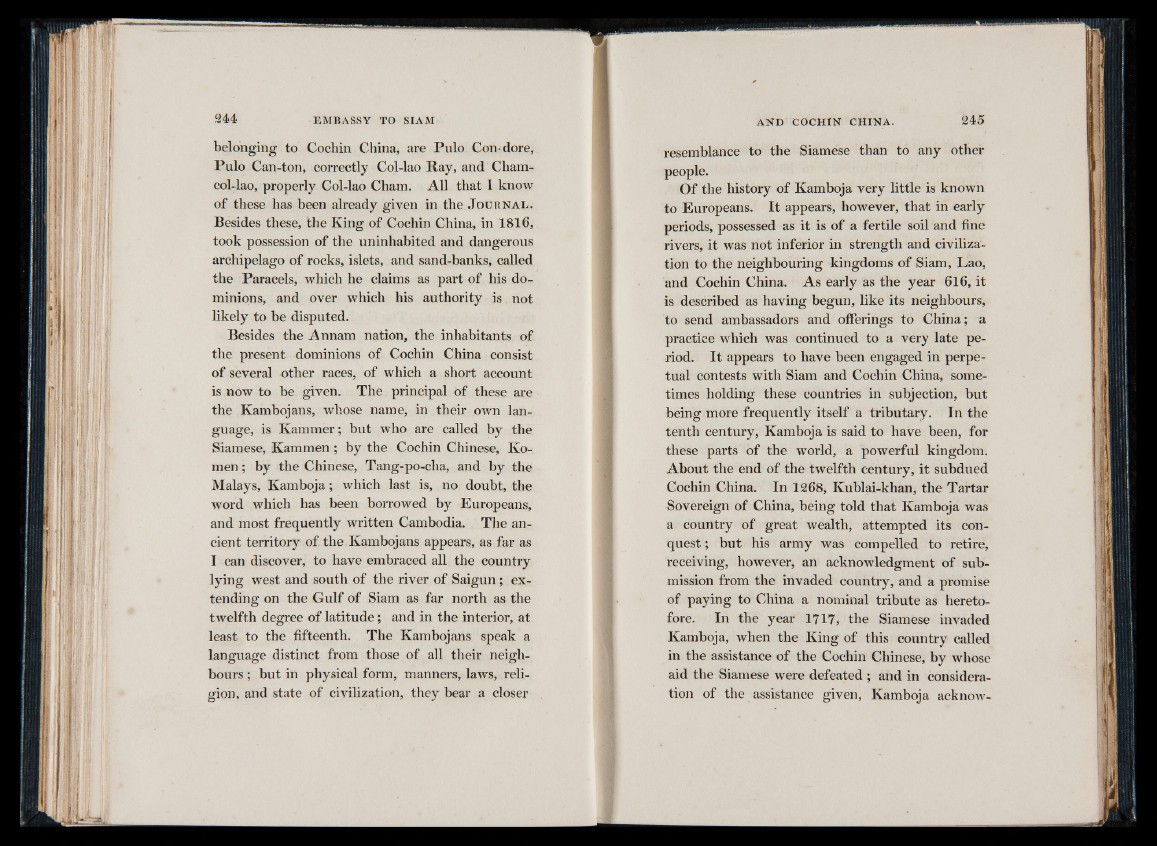
belonging to Cochin China, are Pulo Con-dore,
Pulo Can-ton, correctly Col-lao Ray, and Cham-
col-lao, properly Col-lao Cham. All that I know
of these has been already given in the J o u r n a l .
Besides these, the King of Cochin China, in 1816,
took possession of the uninhabited and dangerous
archipelago of rocks, islets, and sand-banks, called
the Paracels, which he claims as part of his dominions,
and over which his authority is not
likely to be disputed.
Besides the Annam nation, the inhabitants of
the present dominions of Cochin China consist
of several other races, of which a short account
is now to be given. The principal of these are
the Kambojans, whose name, in their own language,
is Kammer; but who are called by the
Siamese, Kammen ; by the Cochin Chinese, Ko-
men; by the Chinese, Tang-po-clia, and by the
Malays, Kamboja; which last is, no doubt, the
word which has been borrowed by Europeans,
and most frequently written Cambodia. The ancient
territory of the Kambojans appears, as far as
I can discover, to have embraced all the country
lying west and south of the river of Saigun; extending
on the Gulf of Siam as far north as the
twelfth degree of latitude; and in the interior, at
least to the fifteenth. The Kambojans speak a
language distinct from those of all their neighbours
; but in physical form, manners, laws, religion,
and state of civilization, they bear a closer
resemblance to the Siamese than to any other
people.
Of the history of Kamboja very little is known
to Europeans. It appears, however, that in early
periods, possessed as it is of a fertile soil and fine
rivers, it was not inferior in strength and civilization
to the neighbouring kingdoms of Siam, Lao,
and Cochin China. As early as the year 616, it
is described as having begun, like its neighbours,
to send ambassadors and offerings to China; a
practice which was continued to a very late period.
I t appears to have been engaged in perpetual
contests with Siam and Cochin China, sometimes
holding these countries in subjection, but
being more frequently itself a tributary. In the
tenth century, Kamboja is said to have been, for
these parts of the world, a powerful kingdom.
About the end of the twelfth century, it subdued
Cochin China. In 1268, Kublai-khan, the Tartar
Sovereign of China, being told that Kamboja was
a country of great wealth, attempted its conquest
; but his army was compelled to retire,
receiving, however, an acknowledgment of submission
from the invaded country, and a promise
of paying to China a nominal tribute as heretofore.
In the year 1717, the Siamese invaded
Kamboja, when the King of this country called
in the assistance of the Cochin Chinese, by whose
aid the Siamese were defeated ; and in consideration
of the assistance given, Kamboja acknow